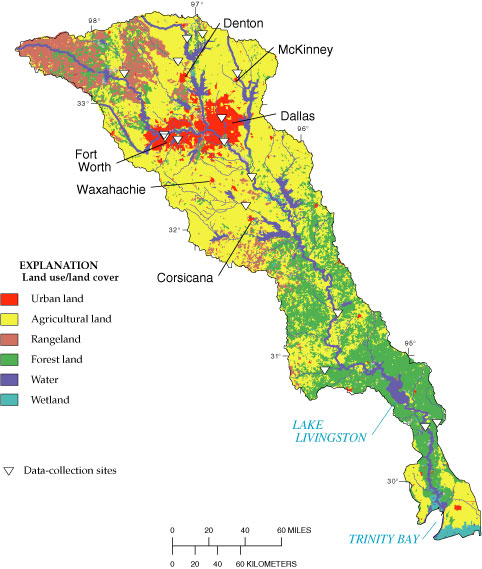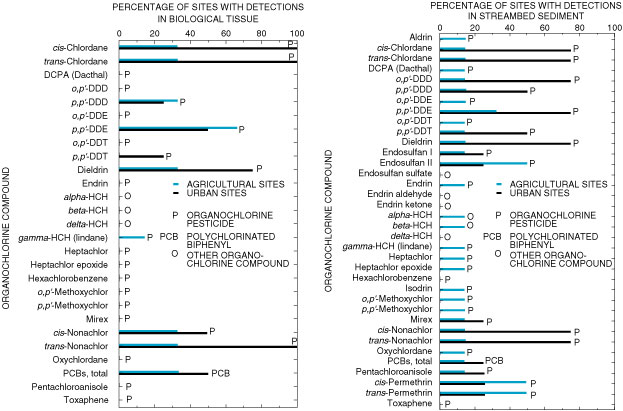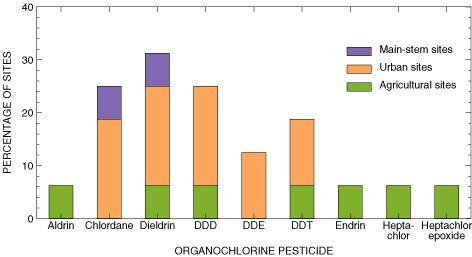


Land-use and streambed-sediment and aquatic-biota collection sites in the Trinity River Basin, Texas.
Use of organochlorine pesticides and PCBs was widespread beginning in the 1940s until bans and use restrictions were placed on these compounds in the 1970s and 1980s. Organochlorine compounds tend to be persistent in the environment. Compounds such as chlordane, DDT and its environmental degradation products (DDD and DDE), and PCBs are water insoluble, are strongly associated with organic carbon and fine sediment, and have long half-lives. Organochlorine compounds were selected by NAWQA for assessment because these compounds are not metabolized rapidly and because they have high bioaccumulation and bioconcentration factors (Crawford and Luoma, 1993).
The distribution of organochlorine compounds in streambed sediments and biota is, in part, a reflection of the historical applications of pesticides. In the Trinity River Basin, pesticide uses were concentrated in agricultural areas, particularly the Blackland Prairie (Ulery and Brown, 1995), and in urban settings such as the Dallas-Fort Worth metropolitan area.
Surficial streambed-sediment and aquatic-biota samples were collected at 16 sites in the Trinity River Basin during late winter 1992 and early spring 1993 (Moring, 1997). Sites on Trinity River tributaries were chosen to reflect general urban, agricultural, rangeland, and forest land-use areas. Aquatic-biota samples from tributary sites were corbicula (asiatic clams). Four Trinity River main-stem sites also were selected. Because corbicula were scarce at the main-stem sites, aquatic-biota samples at these sites were common carp and blue catfish.
Organic compounds contained in chlordane (the sum of all chlordane and nonachlor compounds and oxychlordane), an insecticide typically used for the extermination of termites and fire ants, were more commonly detected in urban streams both in tissues and in sediment. The DDT degradation products, DDD and DDE, were more commonly detected in tissues at agricultural sites and more commonly detected in sediment at urban sites.
At least one concentration of each of nine organochlorine pesticides exceeded the TNRCC screening levels for these pesticides in streambed sediments (Texas Natural Resource Conservation Commission, 1996). These screening levels are based on the 85th-percentile concentration from statewide historical data and are not health or toxicity based. Each exceedance represents 1 of the 16 sites sampled. Concentrations of the insecticide dieldrin more frequently exceeded the TNRCC screening level than did concentrations of any other organochlorines. Urban sites, more than agricultural or Trinity River main-stem sites, had concentrations that exceeded the screening levels for chlordane, dieldrin, DDD, DDE, and DDT. Since their use in agriculture was restricted in the 1970s, chlordane and dieldrin were more extensively used in urban settings. However, DDT commonly was used for pest control in agricultural crops before its ban in 1972. The larger concentrations of DDD, DDE, and DDT in urban stream sediments of the Trinity River Basin could be a result of extensive applications of DDT in the 1950s and 1960s for mosquito control. Aldrin, endrin, heptachlor, and its environmental degradation product, heptachlor epoxide, exceeded their respective TNRCC screening levels only at agricultural sites in the Trinity River Basin. Aldrin, endrin, and heptachlor were used principally on crops such as corn, wheat, and cotton.

Percentage of sites with detections of organochlorine compounds during 1992-93 differs according to land-use practices.

Percentage of sites with organochlorine concentrations in sediments that exceed TNRCC screening levels reflects major land uses and location on the main-stem Trinity River.
| AccessibilityFOIAPrivacyPolicies and Notices | |
 |
|